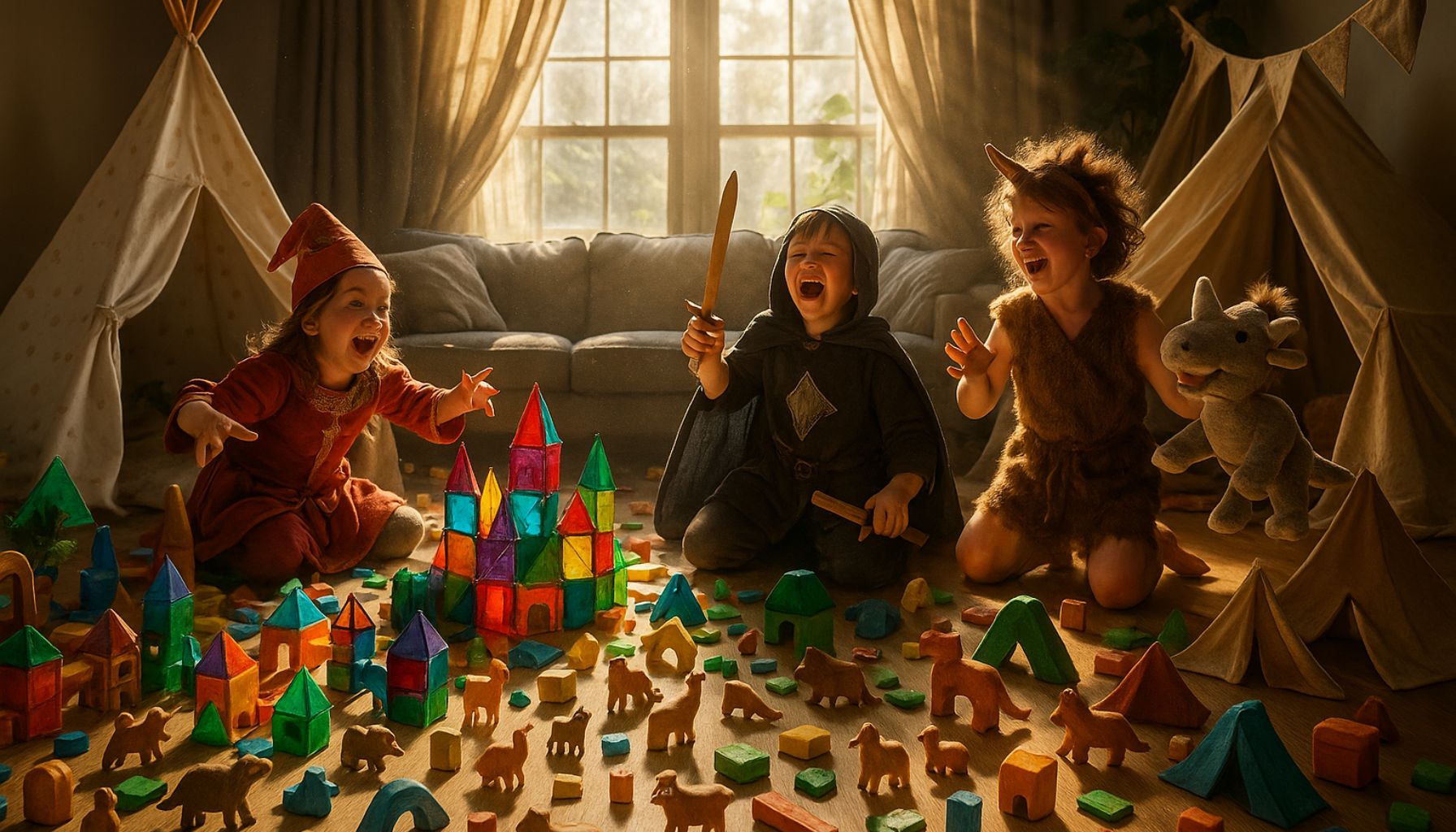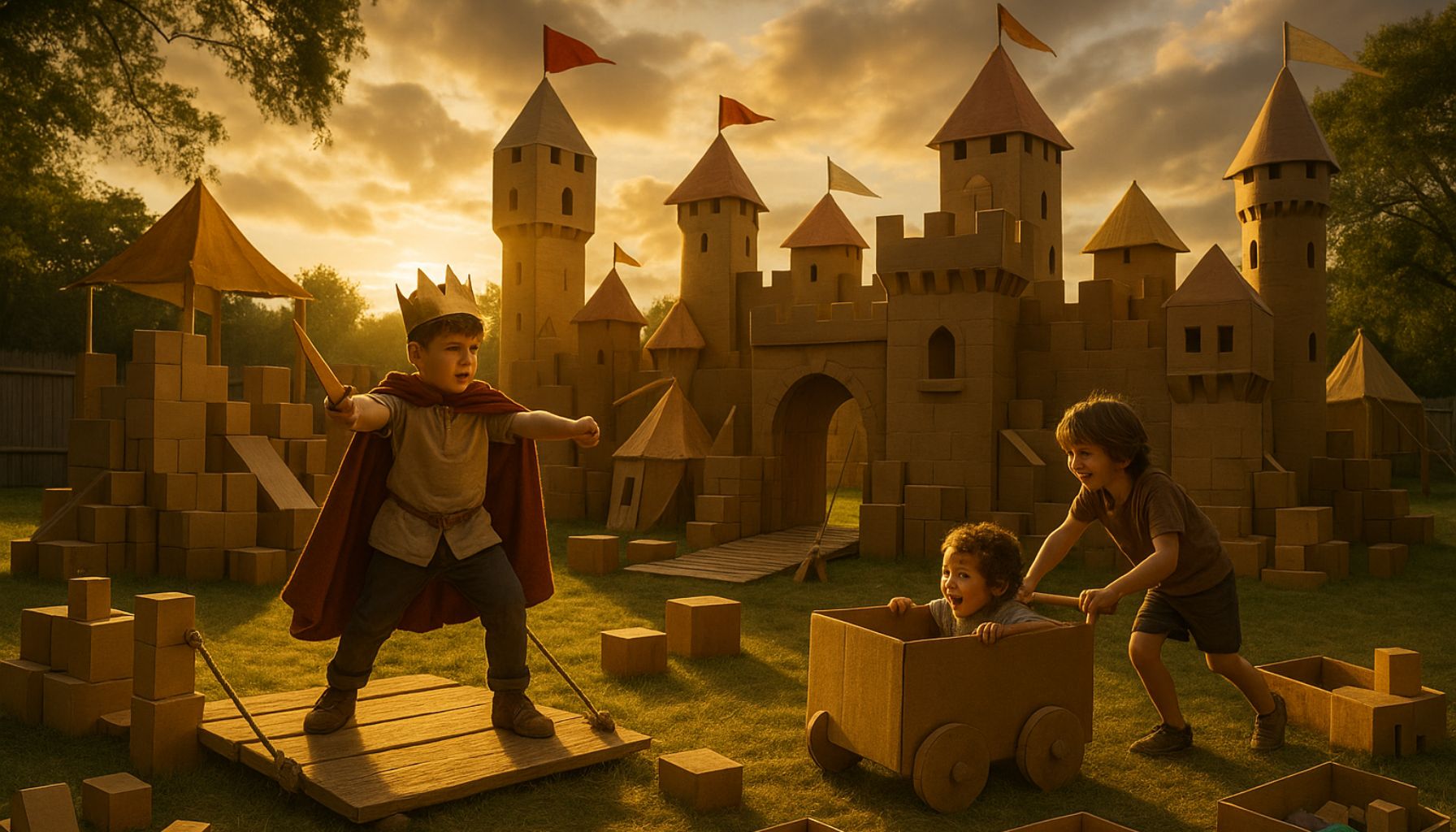In a world where screens vie for a child’s attention, open-ended toys emerge as vivid canvases upon which young minds paint the hues of creativity and exploration. These toys, unlike their structured counterparts, lack instructions, preset objectives, or limits—gifts wrapped in the promise of endless possibilities. Open-ended toys are not just playthings; they are gateways to imagination, sowing seeds of creativity, critical thinking, and adaptability. As children engage with them, they begin to sculpt their fledgling worlds, where dragons breathe fire and dolls embark on interstellar travels.
Faced with the vast ocean of unstructured play, children develop an innate confidence in their ideas and creativity. They build castles in the sky, literally and figuratively, honing their skills and expressing themselves through intricate storylines and grand visions. Fueled by curiosity, open-ended toys become companions in children’s quest to understand the world around them. This form of play encourages children to ask “what if” and embrace the myriad answers that only they can conjure.
Moreover, these toys instill a love of discovery that goes beyond the playroom. The lessons learned within these imaginative realms echo across other areas of their lives, fostering adaptability that will serve them in an ever-changing world. A simple block becomes a complex skyscraper; today it’s a vehicle of whimsy, tomorrow a lesson in perseverance and problem-solving.
Open-ended play, then, is a celebration of the potential within every child. It is through this play that children learn to embrace ambiguity and inventiveness, skills that equip them for boundless exploration and expression.
Understanding Open-Ended Play
Open-ended play invites children to steer their adventures without the constraint of pre-defined rules. In contrast to structured play, where outcomes are predetermined, open-ended play is an ever-evolving journey navigated by the child’s imagination. This distinction is crucial, for it transforms a toy from an object to interact with into an extension of the child’s creativity.
These toys offer limitless possibilities, serving as a scaffold for developmental milestones. When a child engages with such a toy, they step into a realm where they are both creator and storyteller, forging new paths with every session of play. The wooden block isn’t just a block—it’s a bridge, a stage, and a possibility awaiting manifestation.
The educational benefits inherent in these toys are manifold. Through play, children practice problem-solving, developing spatial awareness as they build, create, and navigate their mini-universes. Each session is a lesson in physics, geometry, and negotiation, conducted in the playful language of laughter and exploration.
Free 30-day trial of Amazon Prime
Get your ... Free delivery, award-winning TV, exclusive deals, and more!Key Characteristics of Open-Ended Toys
Defining an open-ended toy often begins with versatility. A toy that can be transformed and repurposed for various roles captivates children for years, keeping their imaginations fresh and constantly engaged. Simplicity also plays a starring role; unadorned toys offer children the power to imbue them with stories and functions of their making.
The charm of these traits is evident in their engagement capacity—long after the initial allure of novelty fades. A single set of blocks, for example, may see numerous reincarnations, each iteration a new story, a new world built from the dreams of a child. This versatile nature encourages repetition, a catalyst for deeper creative exploration.
Parents and educators are urged to prioritize such toys, valuing quality over quantity. In nurturing a child’s natural curiosity and innovation, they provide tools for open-ended play—an investment in the child’s future capacity for creativity and resilience.
Classic Toys: Timeless Imagination Builders
Classic toys like blocks, dolls, and art supplies have long held the throne as central figures in the realm of imaginative play, standing time’s rigorous test. Each timeless piece holds the magic of versatility, an invitation for children to transform them into whatever their minds dare to envision.
Blocks are quintessential, offering endless permutations of castles, spaceships, and anything the heart desires. Dolls, devoid of factory-imposed narratives, welcome children to craft epic chronicles, friendships, and adventures. Art supplies, too, provide an open field for expression, where colors and creativity meet boundlessly.
- Wooden blocks
- Doll and stuffed animal sets
- Simple musical instruments
- Natural materials (leaves, stones, sticks)
- Construction sets (like LEGO)
- Open-ended craft kits
- Scarves and fabrics
- Nesting and stacking toys
- Model animals and people
- Art supplies (crayons, markers, paints)
- Simple vehicles (trains, trucks, cars)
- Puzzles with interchangeable pieces
- Puppet theatres and puppets
- Sand and water toys
The nostalgia woven into these toys brings forth their enduring value. Across generations, they have supported varied aspects of development, ensuring children today enjoy the same imaginative joys their elders once did.
Modern Innovations in Open-Ended Toys
Amidst the treasure trove of classic toys, modern innovations have burgeoned, marrying technology and traditional play. These new entrants have ingeniously integrated play with learning tools that evolve with a child’s burgeoning needs, amplifying creative engagements.
Companies are delicately weaving technology with play to keep pace with ever-changing play landscapes. From digital blocks that mimic real-world play structures to augmented reality storytelling gadgets, creativity remains at the core. These toys stand as bridges between the tactile and virtual, enriching imaginative play while ensuring technology acts as an enhancer, not a replacement.
Finding harmony between traditional and modern play dynamics ensures children experience a balanced approach, where technology fuels rather than hinders creativity. The challenge remains to use such innovations to expand upon, not diminish, the boundless potential housed in open-ended play.
The Role of Open-Ended Toys in Social Development
Open-ended toys are emblematic of collective play, often acting as mediums through which children learn the delicate dance of social interaction. When children engage in cooperative play, these toys become instruments of communication and shared imagination.
Through such collaborative endeavors, children practice negotiation, share ideas, and express creativity. They navigate the give-and-take of joint narrative-building, learning to listen, adapt, and compromise, critical social skills crucial not just in play but throughout life.
| Category | Age Group | Key Benefits |
|---|---|---|
| Wooden blocks | Toddlers – Teens | Creativity, motor skills |
| Puppets | Preschoolers | Storytelling, empathy |
| Building sets | Kids 5+ | Problem-solving, persistence |
| Art supplies | All ages | Self-expression, fine motor skills |
| Musical toys | 3+ years | Rhythm, coordination |
| Dolls & figures | Toddlers – Teens | Social understanding |
| Craft kits | Kids 6+ | Innovation, precision |
| Fabric & scarves | All ages | Dramatic play, imagination |
| Model playsets | Kids 4+ | Scene setting, narrative skills |
| Pretend cooking sets | 3+ years | Role play, creativity |
| Sand & water toys | All ages | Sensory play, experimentation |
| Simple puzzles | 2+ years | Cognitive development, patience |
Facilitating these small societies, open-ended play encourages children to become architects of their shared worlds, sowing the seeds for lifelong social skills development.
Encouraging Imagination with DIY and Homemade Toys
The resurgence of DIY toys in today’s digital age illustrates an enduring love for crafting, bringing parents and children together in the world of tangible creation. The process of crafting homemade toys offers a palette of creativity, inviting personalization and a hands-on appreciation for the fruits of labor.
From converting old household items into instruments of play to crafting new toys from simple materials, DIY toys encourage ingenuity, proving that the adage “necessity is the mother of invention” holds true even in play.
Free 30-day trial of Amazon Prime
Get your ... Free delivery, award-winning TV, exclusive deals, and more!By involving children in the creation of these toys, parents nurture a sense of accomplishment and innovation. This hands-on experience promotes a deeper connection between child and toy, sparking joy and a sense of pride in youthful hearts capable of creation.
Open-Ended Toys Across Different Cultures
Exploring the diverse tapestry of cultures reveals myriad unique toys, each imbued with distinctive traditions that cultivate imagination. Across the globe, different societies employ open-ended toys to spark creativity in ways that echo their cultural heritages.
In Japan, simple wooden tops called Koma embody elegance and tradition, while in Africa, toys like the Makonde drums embody rhythm and storytelling. Indigenous cultures use natural materials, transforming stones, shells, and leaves into instruments of imagination.
With these diverse cultural offerings, integrating a wide array of toys invites children to explore the global landscape of play. This multicultural approach broadens their worldviews, creating a fertile ground for global awareness and empathy.
How to Choose the Right Open-Ended Toy
Selecting the right open-ended toy involves more than a passing glance at the latest trends. Consideration begins with material choices, opting for toys that are both tactile and enduring. Age-appropriateness also plays a crucial role, ensuring toys resonate with the child’s developmental stage.
Balance between simplicity and complexity invites engagement, challenging children without overwhelming them. An eye for versatility is equally vital, choosing toys that can evolve and grow alongside a child’s expanding imagination and interests.
- Observe your child’s interests closely
- Choose toys made from safe, durable materials
- Opt for toys without batteries or electronic components
- Ensure toys are age-appropriate and engaging
- Select toys that offer multiple use scenarios
- Encourage toys that foster creative problem-solving
- Prioritize toys that are easy to manipulate
- Look for toys promoting physical activity
- Favor toys that enhance independent play
- Seek toys with educational potential
- Consider toys that nurture social skills
- Choose toys that require manual operation
- Aim for toys capable of supporting open narratives
Thoughtful selection of toys, tailored to a child’s interests and development, paves the way to more meaningful play experiences that are rich in creativity and lasting developmental rewards.

Conclusion: Embracing Imaginative Play
In the theater of life, open-ended toys act not merely as props but as portals to endless possibilities. They encourage children to conjure entire worlds, think outside conventional frameworks, and live among dreams and creativity. Through imaginative play, children pioneer their paths, equipped with lifelong skills and passions.
Such play offers children the greatest gift: the freedom to explore, imagine, and discover the joy of creation. It helps shape not just their formative years but the futures they dream and aspire towards, teaching them to carry the light of curiosity, creativity, and confidence.
As children engage in this vibrant dance of exploration, parents and educators alike stand by, joyful witnesses to the blossoming of true potential. The world through a child’s eyes is vast, colorful, limitless. And in the hands of open-ended toys, that canvas is theirs to fill with wondrous stories yet untold.
Let us therefore champion the cause of imaginative play, embracing the open-ended toys that are more than objects—they are companions in the journey of discovery, growth, and boundless joy. As we do, we nurture the dreamers, innovators, and creators of tomorrow’s world.

